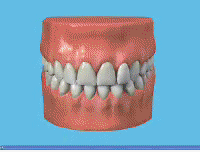 Tooth decay is well known as a phrase, but what is it and how quickly does it form? If I eat lots of sweets over a weekend, will I have a cavity?
Tooth decay is well known as a phrase, but what is it and how quickly does it form? If I eat lots of sweets over a weekend, will I have a cavity?
Decay is the result of bacteria on the surface of our teeth eating sugar – then the bacteria excrete acidic waste products on our teeth – this acid dissolves away the calcium in our tooth enamel and dentine. The soft material left is called ‘decay’.
When the dentist removes this soft decay, the cavity remaining needs to be filled – with a tough and stable filling material.
Decay usually takes about 2 years to form in a typical adult mouth – sooner in those with higher sugar intake. If you have lots of decay in your mouth, this will be due to one or more of the following 3 factors:-
- In children or some adults with soft teeth, this will form much quicker.
- Decay will form more quickly in people who eat several sugary snacks a day, including sweets and biscuits, or even sugar in tea and coffee (the bacteria love the sugar).
- Decay will also form very quickly in a normal person, who doesn’t have weak teeth or eat lots of sweets . . . if they leave some areas of their teeth uncleaned and covered in bacterial plaque.
Fluoride reduces the amount of decay by at least 50% in people – in the UK, this comes mainly from toothpaste.
Because Fluoride toughens the outer layer of enamel, the tooth is more resistant to acid attack.
But if the decay does penetrate the tooth, it is difficult to find it unless your dentist takes regular X-rays of your teeth. This is why we take x-rays every 1-2 years of our patients. We take X-rays of children too when we are worried about decay.






